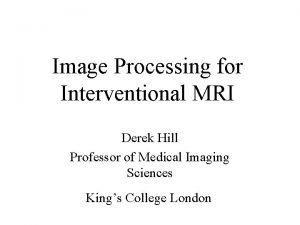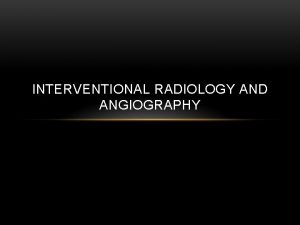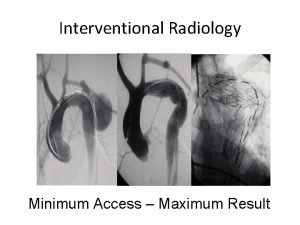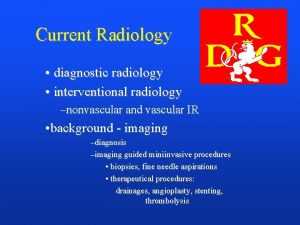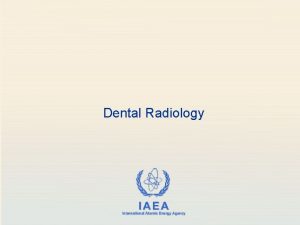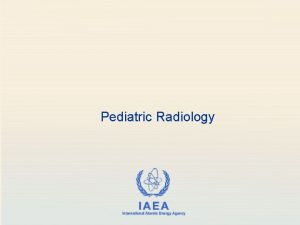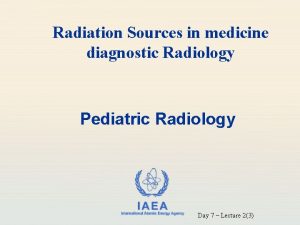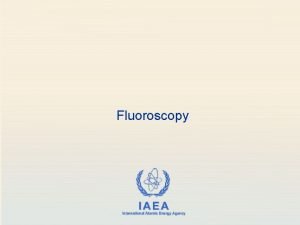Interventional Radiology Authorization and Inspection of Radiation Sources










- Slides: 10

Interventional Radiology

Authorization and Inspection of Radiation Sources in Diagnostic and Interventional Radiology Module 2. 5 Objective • To become familiar with the technology and operation of interventional radiology x-ray systems. • To become familiar with the specific radiation risks for patients and staff associated with interventional radiology. 2

Authorization and Inspection of Radiation Sources in Diagnostic and Interventional Radiology Module 2. 5 Contents • Description of interventional radiology x-ray systems. • Equipment malfunction affecting radiation protection. • Criteria of acceptability and quality control. 3

Authorization and Inspection of Radiation Sources in Diagnostic and Interventional Radiology Module 2. 5 Interventional Radiology Interventional radiology uses x -ray imaging to guide the placement of catheters, stents etc. in blood vessels and organs for the purpose of correcting or treating a particular condition. 4

Authorization and Inspection of Radiation Sources in Diagnostic and Interventional Radiology Module 2. 5 Interventional Radiology (cont) When contrast media is used to outline blood vessels, the technique of digital subtraction angiography (DSA) may also be used. During DSA, a “negative” digital fluoroscopic image of the body part under examination is digitally combined with each frame of the subsequent fluoroscopic image while a contrast medium is injected into the blood vessels. Queensland Diagnostic Imaging The resultant image (in real time or recorded) is displayed largely free of anatomy that might otherwise obscure the blood vessels. 5

Authorization and Inspection of Radiation Sources in Diagnostic and Interventional Radiology Module 2. 5 Interventional Radiology (cont) A fluoroscopic system that can be used for DSA and interventional radiology. 6

Authorization and Inspection of Radiation Sources in Diagnostic and Interventional Radiology Module 2. 5 Interventional Radiology (cont) • Comprises fluoroscopically guided invasive procedures that predominantly have a therapeutic objective. Access to the organ or vessel of interest is usually percutaneous and generally performed under local anesthesia and / or sedation. • Fluoroscopy is commonly used but computed tomography and ultrasound may also be used. • Compared to other fluoroscopic procedures, fluoroscopic exposure times can be long and may be combined with extensive radiographic exposures. • Patient and staff radiation doses can be high. 7

Authorization and Inspection of Radiation Sources in Diagnostic and Interventional Radiology Module 2. 5 Interventional Radiology (cont) • Fluoroscopic systems used for interventional radiology must comply with the basic requirements that are applicable to fluoroscopic equipment (Module 2. 4). • Because the accumulated patient dose may be high, the equipment shall incorporate a continuous indication of patient dose such as a Dose-Area Product meter. • A device must indicate the total elapsed fluoroscopic exposure time for each patient and provide an audible warning to the fluoroscopist at a predetermined interval, preferably not exceeding 5 minutes. 8

Authorization and Inspection of Radiation Sources in Diagnostic and Interventional Radiology Module 2. 5 Malfunctions affecting radiation protection The types of malfunctions that should be considered are: • generator, x-ray tube and imaging system deficiencies listed in Modules 2. 1 and 2. 2, and • fluoroscopy system problems listed in Module 2. 4. 9

Authorization and Inspection of Radiation Sources in Diagnostic and Interventional Radiology Module 2. 5 Problems affecting radiation protection Assuming appropriate dedicated equipment is used, it functions correctly, is properly maintained and is subject to a quality assurance programme, other causes of avoidable patient and staff exposure during interventional radiology might result from: • complex procedures which are not optimized (exposure parameters, the number of images acquired, dose rate, patient positioning, etc. ); • inadequate radiation protection training received by interventional physicians. 10

